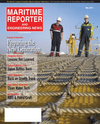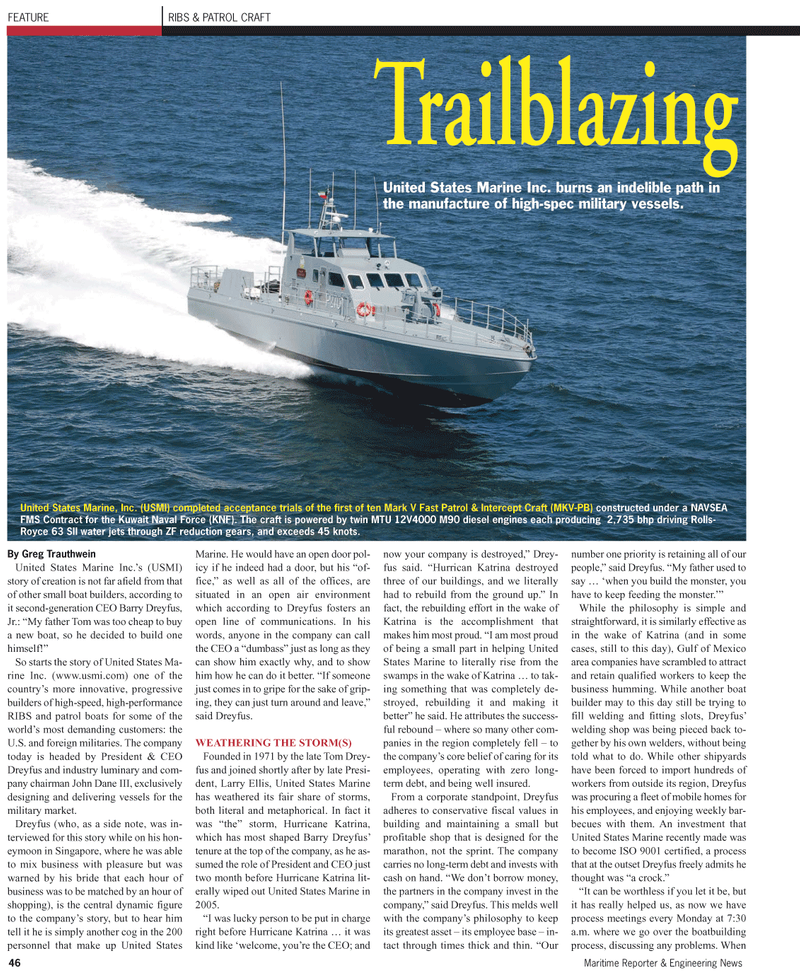
Page 46: of Maritime Reporter Magazine (May 2011)
Training & Education Edition
Read this page in Pdf, Flash or Html5 edition of May 2011 Maritime Reporter Magazine
46 Maritime Reporter & Engineering News
FEATURE RIBS & PATROL CRAFT
By Greg Trauthwein
United States Marine Inc.’s (USMI) story of creation is not far afield from that of other small boat builders, according to it second-generation CEO Barry Dreyfus,
Jr.: “My father Tom was too cheap to buy a new boat, so he decided to build one himself!”
So starts the story of United States Ma- rine Inc. (www.usmi.com) one of the country’s more innovative, progressive builders of high-speed, high-performance
RIBS and patrol boats for some of the world’s most demanding customers: the
U.S. and foreign militaries. The company today is headed by President & CEO
Dreyfus and industry luminary and com- pany chairman John Dane III, exclusively designing and delivering vessels for the military market.
Dreyfus (who, as a side note, was in- terviewed for this story while on his hon- eymoon in Singapore, where he was able to mix business with pleasure but was warned by his bride that each hour of business was to be matched by an hour of shopping), is the central dynamic figure to the company’s story, but to hear him tell it he is simply another cog in the 200 personnel that make up United States
Marine. He would have an open door pol- icy if he indeed had a door, but his “of- fice,” as well as all of the offices, are situated in an open air environment which according to Dreyfus fosters an open line of communications. In his words, anyone in the company can call the CEO a “dumbass” just as long as they can show him exactly why, and to show him how he can do it better. “If someone just comes in to gripe for the sake of grip- ing, they can just turn around and leave,” said Dreyfus.
WEATHERING THE STORM(S)
Founded in 1971 by the late Tom Drey- fus and joined shortly after by late Presi- dent, Larry Ellis, United States Marine has weathered its fair share of storms, both literal and metaphorical. In fact it was “the” storm, Hurricane Katrina, which has most shaped Barry Dreyfus’ tenure at the top of the company, as he as- sumed the role of President and CEO just two month before Hurricane Katrina lit- erally wiped out United States Marine in 2005. “I was lucky person to be put in charge right before Hurricane Katrina … it was kind like ‘welcome, you’re the CEO; and now your company is destroyed,” Drey- fus said. “Hurrican Katrina destroyed three of our buildings, and we literally had to rebuild from the ground up.” In fact, the rebuilding effort in the wake of
Katrina is the accomplishment that makes him most proud. “I am most proud of being a small part in helping United
States Marine to literally rise from the swamps in the wake of Katrina … to tak- ing something that was completely de- stroyed, rebuilding it and making it better” he said. He attributes the success- ful rebound – where so many other com- panies in the region completely fell – to the company’s core belief of caring for its employees, operating with zero long- term debt, and being well insured.
From a corporate standpoint, Dreyfus adheres to conservative fiscal values in building and maintaining a small but profitable shop that is designed for the marathon, not the sprint. The company carries no long-term debt and invests with cash on hand. “We don’t borrow money, the partners in the company invest in the company,” said Dreyfus. This melds well with the company’s philosophy to keep its greatest asset – its employee base – in- tact through times thick and thin. “Our number one priority is retaining all of our people,” said Dreyfus. “My father used to say … ‘when you build the monster, you have to keep feeding the monster.’”
While the philosophy is simple and straightforward, it is similarly effective as in the wake of Katrina (and in some cases, still to this day), Gulf of Mexico area companies have scrambled to attract and retain qualified workers to keep the business humming. While another boat builder may to this day still be trying to fill welding and fitting slots, Dreyfus’ welding shop was being pieced back to- gether by his own welders, without being told what to do. While other shipyards have been forced to import hundreds of workers from outside its region, Dreyfus was procuring a fleet of mobile homes for his employees, and enjoying weekly bar- becues with them. An investment that
United States Marine recently made was to become ISO 9001 certified, a process that at the outset Dreyfus freely admits he thought was “a crock.” “It can be worthless if you let it be, but it has really helped us, as now we have process meetings every Monday at 7:30 a.m. where we go over the boatbuilding process, discussing any problems. When
United States Marine, Inc. (USMI) completed acceptance trials of the first of ten Mark V Fast Patrol & Intercept Craft (MKV-PB) constructed under a NAVSEA
FMS Contract for the Kuwait Naval Force (KNF). The craft is powered by twin MTU 12V4000 M90 diesel engines each producing 2,735 bhp driving Rolls-
Royce 63 SII water jets through ZF reduction gears, and exceeds 45 knots.
Trailblazing
United States Marine Inc. burns an indelible path in the manufacture of high-spec military vessels.

 45
45

 47
47
